

“



“
It’s the question we’d like you to ask when you’ve given your all.
At Citadel, we secure your wealth, and then grow it. The kind of wealth that gives you peace of mind and freedom – the freedom you’ve been working for your whole life. The freedom to do everything or to do nothing. The freedom to choose the size of your dreams and content of your next chapters. It is Beyond Remarkable.
Visit citadel.co.za or follow @CitadelSA and let us take you there.
Personal Finance acknowledges the following people and organisations for their valuable contributions to the success of this year’s Raging Bull Awards:
• Main sponsor: JSE
• Data providers: Iress SA and Apex Group
• Wine and gift sponsors: Klein Constantia Wine Estate, Juniper Moon Gin, John Ross Non-Alcoholic Gin, Sophron Consulting
• Master of Ceremonies: Megan Edwards
• Keynote speaker: Mark Barnes
• Guest speaker: Valdene Reddy
• Venue and catering: Cape Town International Conference Centre
• Event planning: Lutfia Vayej, Rehana Rutti and their team at Independent Media Marketing and Events
• Awards consultant and freelance writer: Martin Hesse
• Sponsorships, advertising and ticket sales: Tony Malek
• Design of certificates and promotional material: Rowan Abrahams at ACM Design Studio.

• Sound and lighting: AV Network
• Photography: Henk Kruger and Armand Hough, Independent Media
• Video production Alan Milne and Justin Miller
• Social media coverage: Tracy-Lee Bieding and Aaqib Simons
• Media ad placements: Robin Gould, Independent Media
• Decor:Decor4U
• Trophy design and manufacture: Purple Puppy Marketing
• Entertainment:Starstruck Entertainment
• Supplement design and layout: Mallory Munien, Independent Media
• Digimag design and layout: Stuart Senar, Independent Media For pictures and other information, visit the Raging Bull Awards website at www.ragingbullawards.co.za




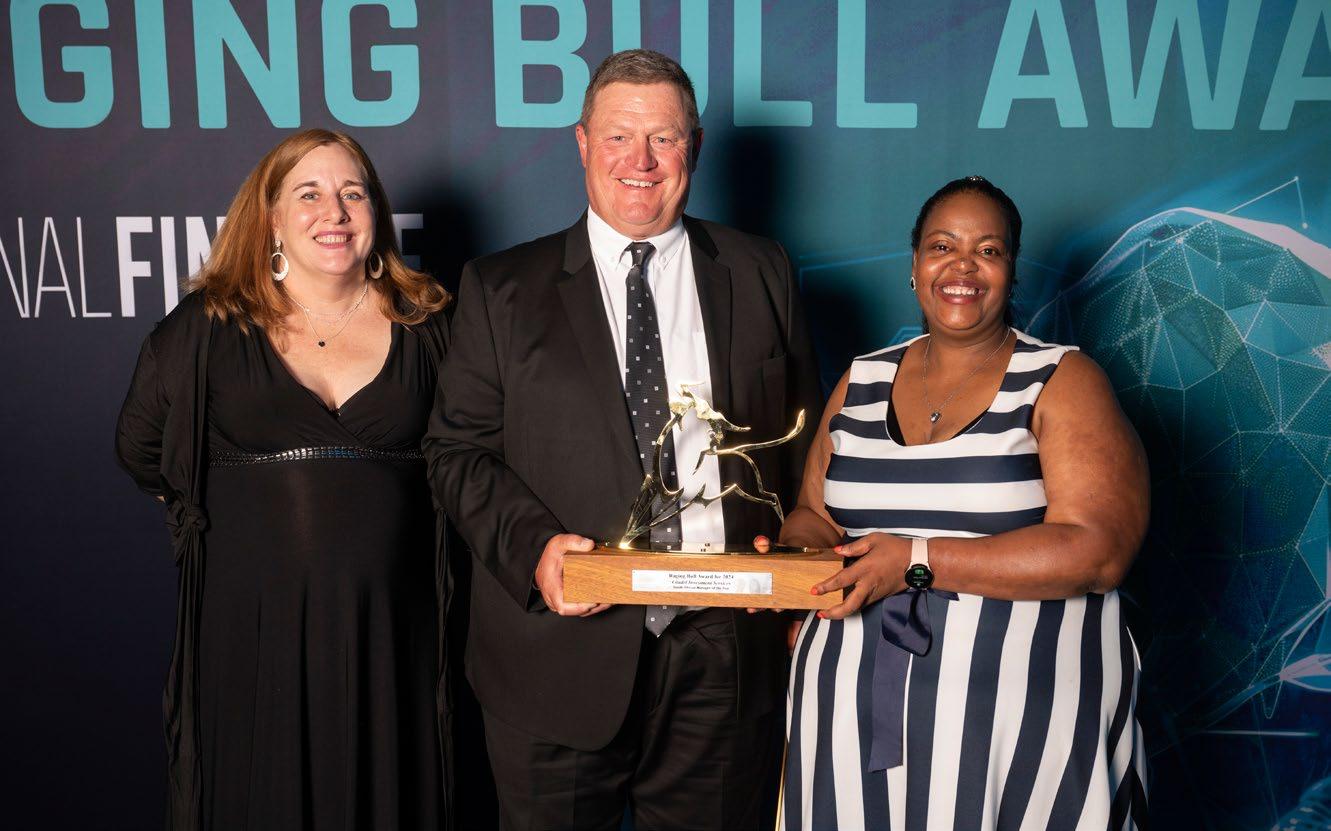

CITADEL Investment Services, the asset management division of the Citadel financial services group, has overcome stiff competition in South Africa’s investment industry to win the coveted South African Manager of the Year trophy at the annual Raging Bull Awards gala dinner, held at the Cape Town International Convention Centre on Monday, February 17, 2025.
The runners-up in the South African Manager of the
Year race were Nedgroup Investments.
The event, sponsored this year by the JSE, recognised outstanding performance to the end of 2024 by collective investment scheme managers. For the first time, the awards included passively managed funds and ETFs. Iress and Apex were the data providers.
The guest speakers at the event were Mark Barnes, founder of Purple Group and former chief executive of the SA Post Office, and Valdene Reddy, the director of capital markets at the JSE.
Dieketseng Maleke, content editor of Personal Finance, said: “Heartiest congratulations to Citadel, which came in ahead of Nedgroup Investments in the manager ratings.
“Citadel and the other winners tonight have demonstrated to investors that they are in good hands if you invest through them. Although it must always be stressed that past performance is no indicator of future performance, a manager’s track record tells you a great deal about its consistency and the quality of its processes.”
This was a first-time win for Citadel, whose top four funds across the eight five-year risk-adjusted categories performed best overall. The company’s top-performing funds, which operate under a H4 Collective Investments licence, were the Citadel Worldwide Flexible H4 Fund, the H4 Diversified Fund, the Citadel SA Multi-Factor Equity H4 Fund, and the Citadel SA Bond H4 Fund.
Citadel Wealth Management was founded in 1993. Over the years it expanded from an advisory practice into a multi-faceted financial services group and currently holds R106 billion in assets under management. Headquartered in Claremont, Cape Town, the group has local offices in Gauteng, KwaZulu-Natal, Eastern Cape and Mpumalanga as well as an offshore presence in Guernsey.
Speaking to Personal Finance after winning the prestigious award, Citadel’s chief investment officer, George Herman, said: “We are humbled by this award. Being recognised as the top performer in the highly competitive financial services and investment industry is a remarkable accolade for us.”

He said that as the awards are based on risk-adjusted performance, they offer a true and unbiased reflection of South Africa’s best-managed funds.
Citadel has always adopted a long-term approach to investing, Herman said. “We never try to dance between the raindrops. Rather, we base our decisions on empirical research and results to inform our investment decisions. This way we remove unnecessary risk from the process,” he said.
Citadel CEO, Andrew Möller, noted that Citadel’s true competitive advantage comes from the company’s focus on people. “Citadel’s investment strategy is dictated by the need to protect our clients’ wealth, which informs our investment ethos,” he said.
The other awards at the event were fund-specific: 16 certificates for straight performance over three years in specialised categories related to the Association for Savings and Investment SA classification system, and eight trophies in broader categories for risk-adjusted performance over five years – all to the end of 2024.
A stand-out among the awards for individual funds was the Investec BCI Dynamic Equity Fund, which won Best SA Equity General Fund for risk-adjusted performance for the third year in a row.
Maleke said the main objective of the annual awards was to guide investors to funds that deliver superior, reliable returns. “This aligns with the ongoing aim at Personal Finance – to provide readers with credible, accessible information on financial services and products to better manage their day-to-day financial affairs and grow their wealth,” she said.
(FoR ReSuLtS to DeCeMBeR 31, 2024)

Straight performance over three years
BeSt SA equItY GeNeRAL FuND Fairtree Select Equity Prescient Fund
BeSt SA equItY SMALL AND MeDIuM CAP FuND Coronation Smaller Companies Fund
SA MuLtI-ASSet HIGH equItY FuND Granate BCI Balanced Fund
BeSt SA MuLtI-ASSet MeDIuM equItY FuND Nedgroup Investments Opportunity Fund
BeSt SA MuLtI-ASSet Low equItY FuND Camissa Stable Fund
BeSt SA MuLtI-ASSet FLexIBLe FuND Granate BCI Flexible Fund
BeSt SA MuLtI-ASSet INCoMe FuND PortfolioMetrix BCI Dynamic Income Fund
BeSt SA INteReSt-BeARING VARIABLe-teRM FuND
M&G Bond Fund
Best SA Interest-Bearing Short-Term Fund
Truffle SCI Income Plus Fund
BeSt SA ReAL eStAte FuND
M&G Property Fund
BeSt woRLDwIDe equItY GeNeRAL FuND
Nest Egg BCI Worldwide Equity Fund
BeSt woRLDwIDe MuLtI-ASSet FLexIBLe FuND
Blue Quadrant Worldwide Flexible Prescient Fund
BeSt GLoBAL equItY GeNeRAL FuND
Sygnia FANG.AI Equity Fund
BeSt GLoBAL MuLtI-ASSet HIGH equItY FuND
Allan Gray-Orbis Global Balanced Feeder Fund
BeSt GLoBAL MuLtI-ASSet FLexIBLe FuND
Global Marathon IP Fund
BeSt GLoBAL ReAL eStAte FuND
Oasis Crescent International Property Equity Feeder Fund

Risk-adjusted performance over five years
BeSt SA equItY GeNeRAL FuND Investec BCI Dynamic Equity Fund
BeSt SA MuLtI-ASSet FuND Visio BCI Actinio Fund
BeSt SA INteReSt-BeARING FuND Terebinth SCI Enhanced Income Fund
BeSt woRLDwIDe FuND Blue Quadrant Worldwide Flexible Prescient Fund
BeSt GLoBAL equItY FuND PSG Global Equity Feeder Fund
BeSt GLoBAL MuLtI-ASSet FuND Global Marathon IP Fund
BeSt GLoBAL INteReSt-BeARING FuND M&G Global Bond Feeder Fund
BeSt ReAL eStAte FuND Harvard House BCI Property Fund
Five years performance
CItADeL INVeStMeNt SeRVICeS Nedgroup Investments – Runner-up (certificate)
Are you struggling with multiple systems?
Simplify your operations with One Platform for Market Data Insights, Portfolio management, Compliance & Trading!
Are you struggling with?
1. Fragmented Workflows
2. Inefficient Trading & Market Data Access
3. Compliance & Regulation Risks
4. Lack of Integration with Fund Administrators
5. Complex Trade Execution and Allocations
• A unified front-end experience that integrates portfolio management, market data, and trading.
• Access to integrated market data with multi-asset order routing and pre-trade compliance tools.
• Built-in compliance monitoring with customisable rules and real-time alerts.
• Seamless integration with fund administrators for automated processes.
• Electronic trading workflows with editable and auditable trade records.
• Single Source of Truth: Eliminate scattered data.
• Pre-Trade & Post-Trade Visibility: Ensure risk and compliance checks before execution.
• Audit-Ready & Secure: Enjoy electronic and compliant actions.
• Reduce Manual Errors: Benefit from automated reconciliations.
• Seamless Reporting & Analysis: Generate reports effortlessly.
• Integrated Trading: Direct broker access via SmartHub.
• Operational Efficiency: Experience real-time updates.
• All in One Place: Market insights, compliance, and trading at your fingertips.
Your Day, Simplified!
• Raging Bull Award: Best Worldwide Fund for Risk-Adjusted performance over Five Years to December 31, 2024
• Raging Bull certificate: Best Worldwide Multi-Asset Flexible Fund for straight performance over three Years to December 31, 2024
BLUE Quadrant Capital Management is a boutique asset manager based in Newlands, Cape Town, that is narrowly focused on just three investment portfolios: a unit trust fund (the Blue Quadrant Worldwide Flexible Prescient Fund), a capital growth hedge fund, and an offshore capital growth fund denominated in US dollars. It operates the funds under a Prescient license.
The Blue Quadrant Worldwide Flexible Prescient Fund’s primary objective is to generate high long-term returns. This sub-category of funds has the widest universe of underlying investments of any sub-category in the categorisation of funds by the Association for Savings and Investment South Africa. It can invest any proportion of its portfolio in any geography, local or offshore, in any recognised asset class of listed shares, listed property, bonds or cash instruments. This gives the portfolio manager the scope and flexibility to find investment opportunities, wherever and in whichever asset class they may be.
Portfolio manager and co-founder of Blue Quadrant, Leandro Gastaldi focuses almost exclusively on the worldwide equities market. As at December 31, 2024, 93.2% of the portfolio was in equities (25.3% South African and 67.9% offshore), and among the top five holdings, four were in the energy sector (Seadrill, Cenovus Energy, Pan African Resources and Murphy Oil).
Gastaldi must be doing something right, because his fund has produced annualised returns of 35.2% over the past five years, against 18% of its benchmark, the MSCI World Total Return Index.
Personal Finance asked him about his experience with the fund:
PF: Please explain your philosophy regarding asset allocation, offshore exposure and security selection at asset-class level.
LG: The fund is primarily equity-centric and will always likely have a high allocation to equities. The flexible part of our mandate is mainly used to vary cash levels in the fund, and this variation is mainly a function of the available opportunity set of high reward versus risk opportunities we can find in the equity market.
PF: To what do you attribute your outstanding annualised performance of 35% over five years; almost double your benchmark?
LG: We did very well coming out of the Covid-induced

manager of the
worldwide

panic, retaining and adding exposure to beaten down sectors such as cyclicals and energy.
PF: Were there any specific stand-outs for you over the period at security level?
LG: We took a position in Thungela Resources when it listed in June 2021 after being spun out of Anglo American. The company listed at a very depressed valuation amid extremely negative sentiment, trading initially at R30. The share price then went up 10 times, reaching R300 by August 2022.
PF: The near-term future looks choppy for financial markets –how are you positioning the fund for the next year or so?
LG: We don’t look to time markets and don’t have a specific view of market direction on a 12-month time frame. We expect our portfolio of undervalued companies to continue performing well over a three to five-year timeframe, regardless of general market conditions.
PF: At the end of 2024 you were two-thirds invested in offshore equities and about 25% in SA equities. Do you see opportunities in the local market that may change that ratio more in favour of SA?
LG: No, I don’t think we would increase our South African exposure at this juncture – 25% is already fairly high.
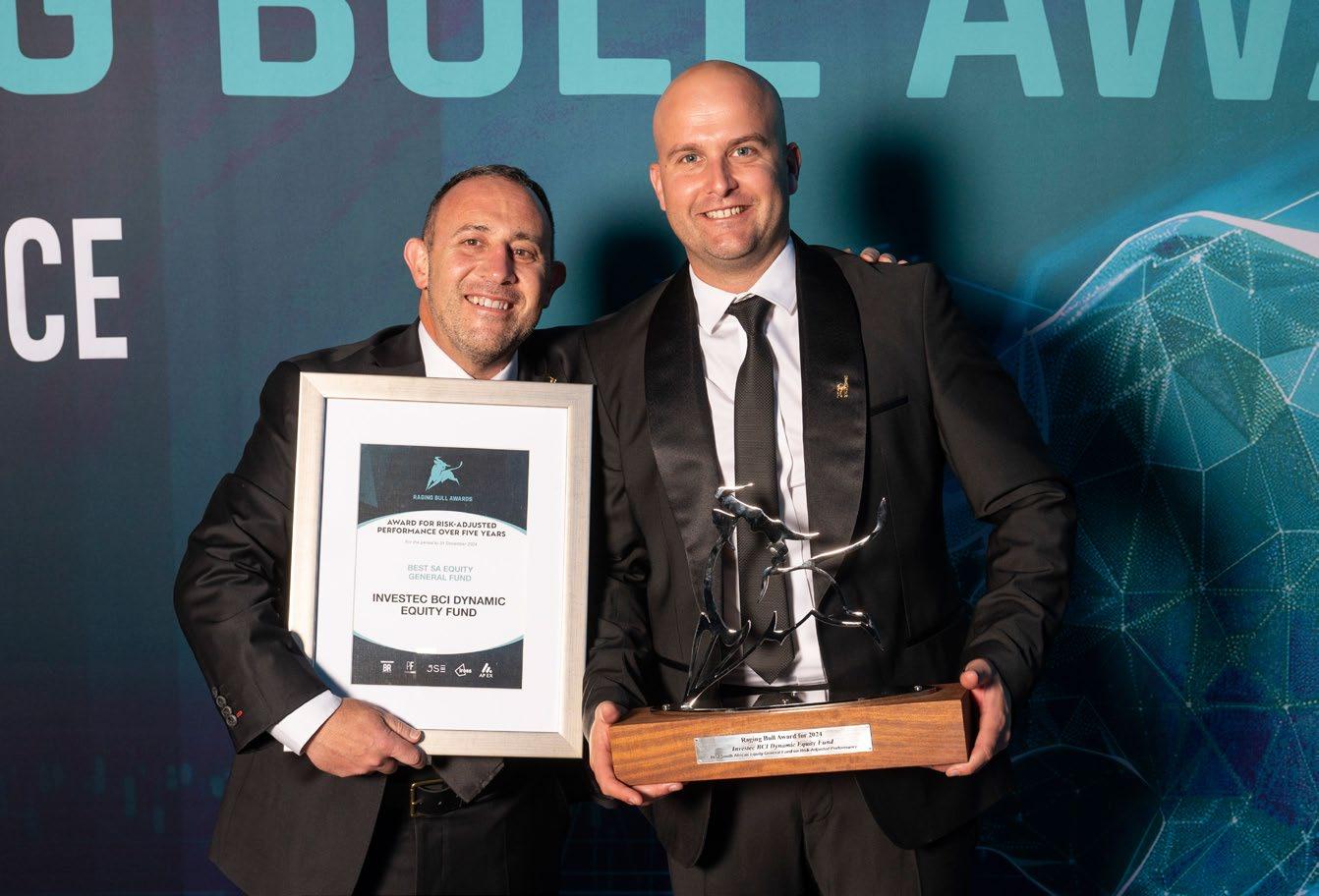

THE Investec BCI Dynamic Equity Fund is one of a suite of domestic and offshore funds offered by Investec Investment Management under the Boutique Collective Investments licence. This is the third year in a row that the fund has won this prestigious award.
It is fully invested in the domestic market with no offshore component, and thus falls into the Asisa SA Equity SA General subcategory which, for the purposes of this event, was included under the SA Equity General subcategory.
Despite having no direct offshore exposure, the fund returned an annualised 20.7% a year over the past five years, double the return of its benchmark, the FTSE/JSE Capped Swix All Share Total Return Index (10.3%).
Personal Finance asked portfolio managers Barry
Shamley and Peter Vogel about their investment approach.
PF: What is the objective of the fund and your investment approach in achieving that objective?
BS & PV: The objective of the Investec BCI Dynamic Equity Fund is to provide investors with capital growth and income over the long term. The fund employs a primarily “bottom-up” approach, attempting to identify equities that offer above-average returns. We have a value bias but are style agnostic and prefer buying companies where there is a large margin of safety in the valuation. We do invest in growth companies, but are price sensitive. We invest across the market-cap spectrum, with the flexibility to invest in compa-

nies that are generally under-researched and often undervalued. While we are not an activist fund, we do regularly pursue targeted engagements on key issues such as strategy and remuneration, including where inappropriate incentive structures encourage value-destructive behaviour. Our equity research team has over 200 years’ experience and provides a robust platform from which we can navigate the ever-changing South African investment landscape.
PF: To what do you attribute your fund’s excellent performance over the last five years?
BS: Our greatest contribution to return over the past five years has come from the materials sector and in particular precious metals. Some of the highlights were Pan African Resources, which we have subsequently reduced, Gold Fields and Royal Bafokeng Platinum, both of which we have exited. Montauk Renewables, a US-based company that extracts and sells gas from landfills (and soon from hog manure) was also an outstanding performer. Another notable contributor to performance is Naspers, which we purchased with some of the proceeds of our Montauk success and we continue to hold it. There were a number of other great South African companies that contributed to performance and that we continue to hold, including Stadio, KAL Group, Sabvest, HCI, Hudaco, Novus and Afrimat. These are all companies where we have identified strong leadership teams that are excellent capital allocators with a sharp focus on return on capital.
PV: One of our most rewarding investments over the last year has been Nampak. Nampak sits firmly in the “turnaround” camp, and while we tend to avoid turnaround plays, Nampak had the right ingredients to be a successful investment. Together with other large shareholders, we actively engaged with the
management of Nampak on a more comprehensive turnaround plan, which skilfully executed by CEO Phil Roux, has led to a material recovery in profitability, a significantly better balance sheet and an approximately 150% share price gain since our investment. We believe that Nampak will continue to go from strength to strength as it focuses on its core canning business.
PF: How are you positioning the fund going forward, considering heightened geopolitical uncertainty, yet a brighter-looking local economy than this time last year?
BS: We break our portfolio down into five factors: SA Inc plays, rand hedge plays, precious metals plays, commodity price plays and SA defensive plays. We positioned our portfolio well going into the South African elections of 2024 with an increased exposure to SA Inc. This was premised on a notable improvement in the performance of state-owned enterprises, particularly Eskom, the outlook for interest rates, and valuations. Many of our larger consumer discretionary companies performed well over the year. We have been trimming some of these strong performers that have substantially rerated and moderately increasing some of our rand-hedge exposure on the back of attractive valuations and strong medium-term outlook. Examples of this include a new position in Bidcorp and an increased weighting in Reinet. We have slightly reduced some of our commodity price play exposure and have maintained our exposure to SA defensive and precious-metal plays. We remain optimistic about the outlook for South Africa despite recent developments, but ultimately valuation, growth, return on capital and good governance remain the cornerstones of our strategy.

Powering innovation in African financial markets for a more connected, efficient and innovative environment.

Introducing JSE-FIX. The new robust order routing service that reduces the cost of managing multiple client connections by providing market participants with a scalable solution, that is vendor, venue and asset class agnostic. JSE member firms can receive orders and send trade confirmations electronically across different asset classes listed on the exchange, while integrating seamlessly with their execution management processes.
In collaboration with Rapid Addition, a leader in providing electronic trading and connectivity solutions, JSEFIX reflects the shared vision to reduce the cost and complexity of trading, by addressing the challenges of high cost of ownership and integration complexity associated with counterparty connectivity, making direct market access more attainable than ever.
Learn more colocation@jse.co.za jse.co.za

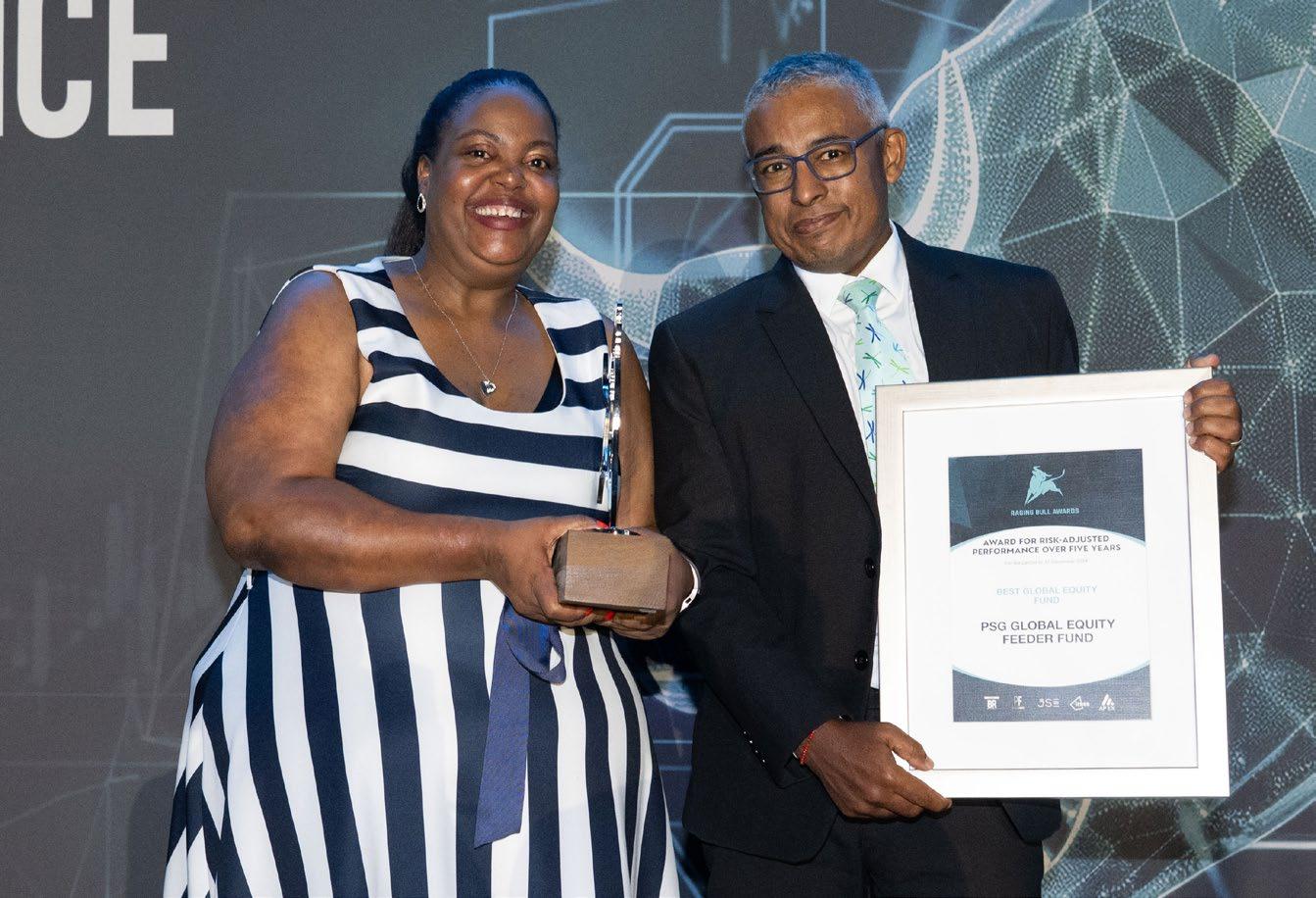

PSG’s Global Equity Feeder Fund is a rand-denominated fund that invests solely in the PSG Global Equity SubFund, a sub-fund of PSG Global Funds SICAV PLC, denominated in US dollars. Over the five years to the end of 2024 it delivered an annualised 13% a year in rand terms.
Fund manager Philipp Wörz responded to Personal Finance on behalf of the team managing this fund (which includes Greg Hopkins and Justin Floor).
PF: Can you outline your investment process, referring to stock selection and regional allocation?
PW: Our process is research driven, long-term, benchmark agnostic and fundamentally bottom-up. We have been investing in global markets since 2008 by consistently applying our 3M (moat, management, margin of safety) investment framework. We look to invest in companies where the underlying quality dynamics (moat and management) are significantly undervalued

(margin of safety).
Some of the most fruitful investments are made in times of fear and uncertainty. Our approach often leads us to uncrowded areas where prices and expectations are often low. When investing in more cyclical sectors, we place strong emphasis on an industry’s supply side, and favour investments with highly asymmetric payoff structures: significant upside and little downside. The fund diversifies across industries, currencies and geographies.
PF: Despite taking a knock in 2024, the fund’s riskadjusted performance over five years has been outstanding. Can you describe the journey and how you avoided much of the volatility?
PW: During the Covid-19 related sell off in early 2020, the fund repositioned its holdings towards beneficiaries of a recovery. Then in late 2021, early 2022, at a time when US stocks generally and technology stocks in particular were trading at stretched valuations and were highly vulnerable to increases in interest rates, we positioned the fund towards opportunities that were benefiting from the onset of inflationary pressures, which resulted in the fund delivering a positive return of 7% in 2022 compared to the MSCI World Index’s negative 18%.
PF: Where have you found opportunities that have paid off for you?
PW: The fund’s return contributors over that past five years spanned a diverse set of industries and geographies, including UK defence companies, global shipping stocks (across Denmark, Norway, Greece and Monaco), US pension providers, Canadian based fertiliser and gold royalty stocks and Japanese banks.
PF: How are you positioning the fund going forward, considering worries about trade wars and the unstable geopolitical situation?
PW: News flow and executive orders emanating from the White House contribute to an uncertain geopolitical environment. This coupled with record high index concentration – where a small number of companies account for an outsized portion – remind us of conditions last seen in the 1970s and late 1990s and warrant caution going forward. Elevated valuation levels for large index constituents suggest limited mediumto long-term returns from global equity indices at current levels. Conversely, there is an abundance of opportunities outside the areas currently dominating global markets and we are finding attractive investment opportunities in areas of the market that have been characterised by elevated levels of fear and low levels of market appetite (and attractive valuations, as a result). These tend to be in international markets outside of the United States in markets such as the UK, Hong Kong, Brazil and select European opportunities.

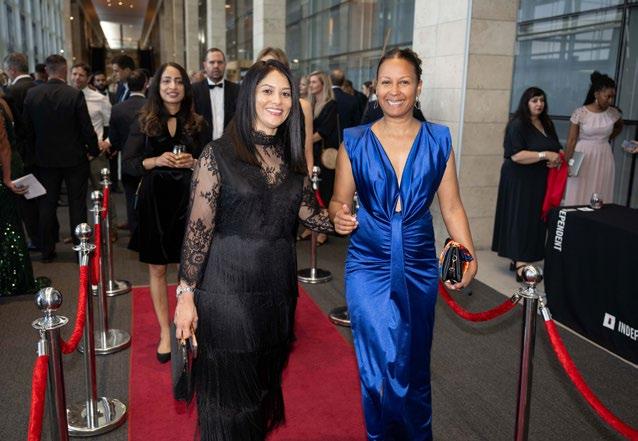
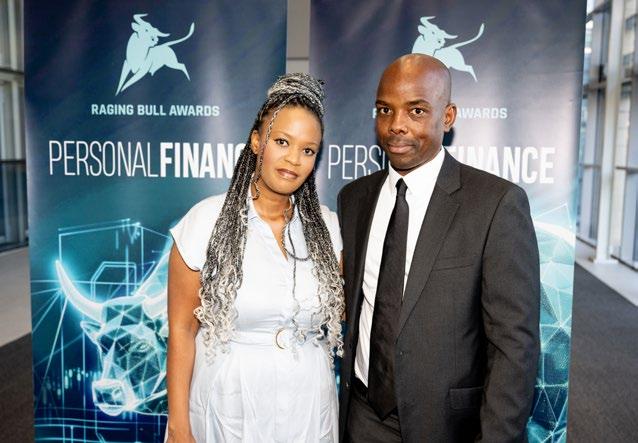
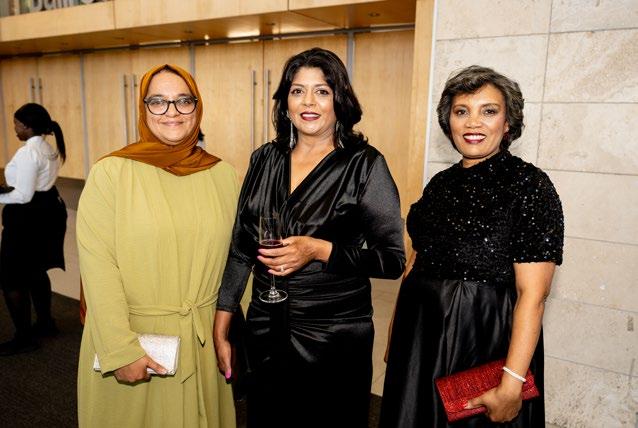
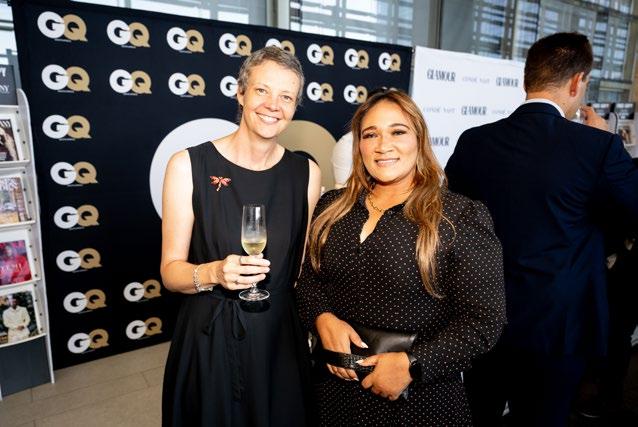
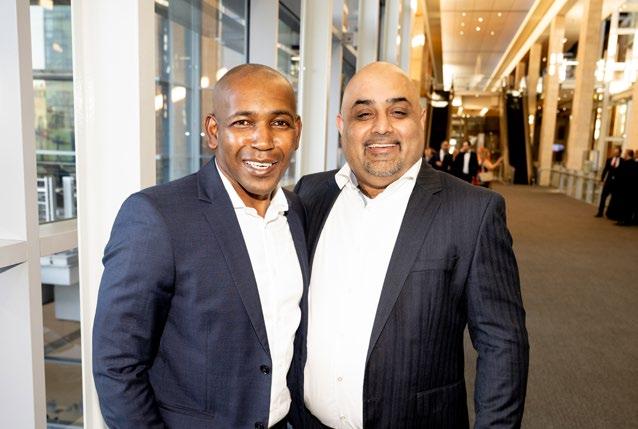
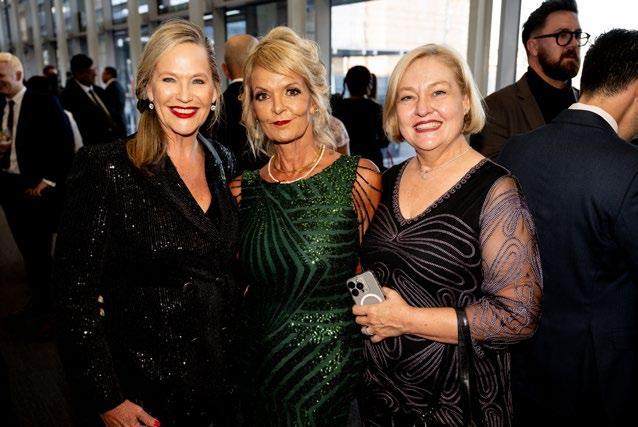





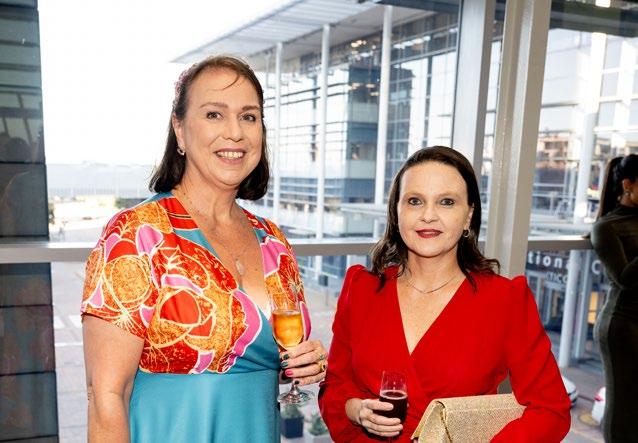











CONSTANTIA - R46,995,000 - SOPHISTICATION & REFINED LUXURY
Perched high above Constantia, Beau Glen redefines exclusivity. 3 Architecturally masterful villas, breathtaking valley views, and an unrivalled living experience await.
ALEXA HORNE 082 349 7799 | PAUL UPTON 071 610 8088


BISHOPSCOURT - R36,000,000 - MUCH-LOVED FAMILY HOME
This stunning property seamlessly combines luxurious living with practical functionality, making it an ideal choice for families. Excellent security.
ALEXA HORNE 082 349 7799 | alexa@dgproperties.co.za


CONSTANTIA - R34,950,000 - A HAVEN OF SERENITY
Set in the lush enclave of Bel Ombre, Upper Constantia, Villa Bel Ombre is an exclusive eco-residential estate featuring four bespoke homes.
ALEXA HORNE 082 349 7799 | PAUL UPTON 071 610 8088
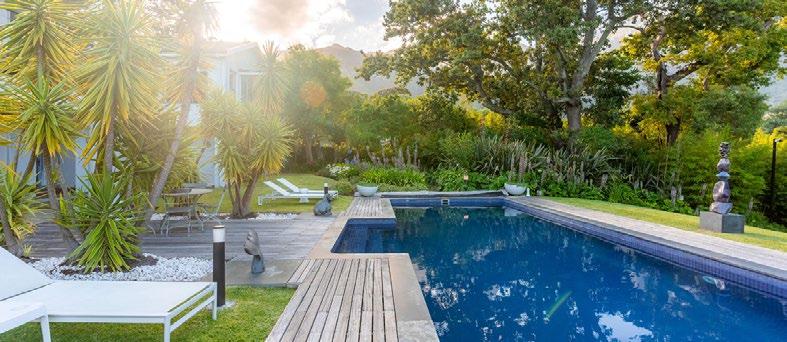

BISHOPSCOURT - R37,000,000 - BISHOPSCOURT GEM
This truly exquisite home situated in the exclusive suburb of Bishopscourt offers the discerning buyer the very best in modern living.
ALEXA HORNE 082 349 7799 | alexa@dgproperties.co.za


BISHOPSCOURT - P.O.A. - INCOMPARABLE ELEGANCE
Capturing the essence of contemporary architecture, The Grace is a study in design purity. Complete focus on lifestyle needs has been achieved without excess.
HORNE 082 349 7799
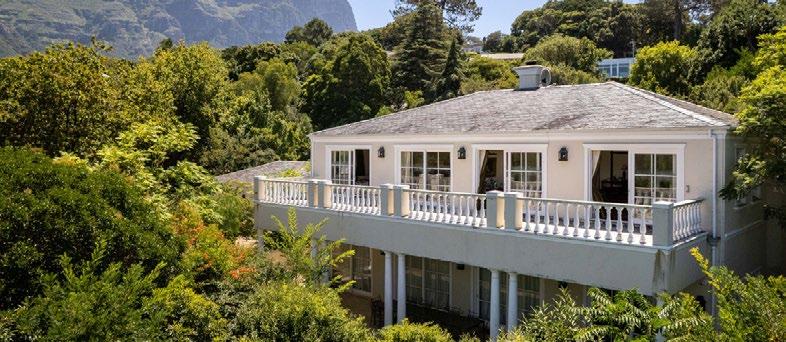

Nestled in a prestigious suburb, this magnificent property set on 3,827m² land offers breathtaking views over the picturesque Constantia Valley.


The





THE M&G Global Bond Feeder Fund is a rand-denominated fund that feeds into M&G’s Global Bond Fund, denominated in US dollars and domiciled in Ireland. This fund is aimed at investors seeking returns from a diversified portfolio of global debt and fixed-income securities.
In a tough global bond market over the last five years, the fund achieved 2.9% annualised, the best in its peer group for risk-adjusted performance.
Joe Sullivan-Bissett, fixed-income investment director at M&G Investments, was interviewed by Personal Finance on how the fund is managed.
PF: Please explain your investment process regarding the international bond market.
JS-B: The construction of the fund involves decisions about the allocation to various asset classes – government bonds, corporate bonds, emerging markets – as well as individual bonds and currencies.
As part of our investment process, we identify macroeconomic trends and overarching policy regimes. We consider the long-term potential for growth and inflation within an economy, which is significantly influenced by central bank policies, inflation targets, broader economic cycles, and thematic disruptors.
With that valuation framework in mind, we have a wealth of opportunities to benefit from in the duration space. We can be long or short duration at a fund level depending on our view of long-term rates and where we are in the economic cycle. In addition to duration positioning, opportunities may be present along the yield curve, as a result of factors that influence the relative steepness of yield curves across different geographies. Lastly, we seek opportunities through bottom-up analysis of individual bonds and aim to benefit where there are notable mispricings along the yield curve.


PF: How has the global bond market fared over the last five years, and to what do you attribute your fund’s superior performance?
JS-B: Over the past five years, the bond market has experienced significant volatility and transformation. Bond yields have fluctuated dramatically, influenced by shifting market narratives and occasional over-reactions to what later proved to be inconsequential news or data points. For active fund managers like us, these fluctuations present opportunities, as they can lead to asset mispricing relative to their fundamentals. Our role is to navigate through the noise and volatility, identifying and investing where we see true value.
Prior to the Covid-19 pandemic, the bond market was characterised by low interest rates and limited opportunities in credit. The pandemic disrupted the market, initially causing severe impacts on risk assets and leading to a significant widening of credit spreads. This created an opportunity for active managers to overweight credit at attractive valuations and benefit from the subsequent tightening driven by accommodative policies from governments and central banks. The increase in money supply during this period eventually led to inflationary pressures not seen in decades. While it was unsurprising, given that inflation typically follows money supply with an 18-month lag, the market initially debated the transitory nature of these pressures. Once it became evident that inflation was persistent, central banks took action, albeit potentially too late. The year 2022 was particularly challenging for fixed-income markets as interest rates rose significantly in response to the anticipated tightening needed to control inflation expectations.
PF: How are you positioning the fund going forward in the face of probable trade wars, geopolitical turmoil,
and a possible uptick in inflation?
JS-B: As we move through 2025, global monetary policy remains restrictive with interest rates above what might be considered the long-term neutral rate. The complexity of monetary policy, compounded by its delayed impact on the real economy, makes policy decision-making difficult. However, the challenges faced by central banks present opportunities for active investors.
Government bond markets have been volatile as investors assess the impact of restrictive monetary policy and President Trump’s policy on inflation and growth. The economy is slowing, and central banks are likely to ease policy gradually unless a significant economic slowdown occurs. However, Trump’s approach to trade policy and tariffs may well be inflationary, adding a layer of uncertainty for the US Federal Reserve, meaning the timing around further easing is unclear. We are currently running a neutral duration position overall, and within developed markets we prefer exposure to UK and Australian rates. In emerging markets, we are significantly underweight China with the view that weak growth, issues surrounding the property sector and uncertainty about the level of stimulative policy required to encourage a recovery in growth, will weigh on the country’s fortunes. We hold this short against other attractively valued emerging markets, such as Brazil and Indonesia. Japan, after decades of low growth, has begun to normalise policy. Although this will likely be gradual, convergence with other developed markets should support the yen. Conversely, Europe is facing challenges. Growth metrics are declining, with Germany significantly underperforming and France dealing with political issues. The European Central Bank may need to cut rates substantially to prevent a considerable slowdown.
• Raging Bull Award: Best Global Multi-Asset Fund for Risk-Adjusted performance over Five Years to December 31, 2024
• Raging Bull certificate: Best Global Multi-Asset Flexible Fund for straight performance over three Years to December 31, 2024


THE Global Marathon IP Fund forms part of a basket of funds managed by boutique asset manager MiPlan, based in Newlands, Cape Town.
According to the fund’s minimum disclosure document, the objective of this portfolio is to achieve longterm capital appreciation. There are no limitations on the relative exposure of the portfolio to any asset class, but it typically has significant exposure to foreign equity
and property securities (its foreign equity holding in December 2024 was 81%).
The fund’s biggest holdings in December 2024 included six of the “Magnificent Seven” US tech stocks: Apple, Nvidia, Microsoft, Amazon, Alphabet and Meta (the seventh, not in its top holdings, being Tesla). Also in the top 10 holdings were US bank JP Morgan Chase, US asset manager Blackstone and miner Anglo American PLC.

Over the five-year period, the fund returned 16.7% annualised, above its benchmark (80% MSCI World Index, 15% S&P Developed Property Net Return Index, 5% STeFI), which returned 15.6%.
Personal Finance found out more about the fund and its investment approach from fund manager Tony Bell.
PF: Please explain your investment philosophy and process when deciding on allocations at geographical and asset-class level as well as at securities level.
TB: Our process looks to segment the top 700 global companies into tertiles regarding their ex-ante earnings growth prospects. We then map each tertile in a system called iMaps and analyse it at cluster and geographic levels. Stocks are selected within each cluster to provide the best exposure for a set of earnings growth drivers while minimising selection risk. This process also allows us to position the portfolio into various economically sensitive quadrants, ensuring active risk (tracking error) is where we want it to be and not just looked at in comparison to an index.
PF: The fund has achieved superior risk-adjusted returns
over the past five years, beating your benchmark by over 1% annualised. To what do you attribute your success, and what counters stood out for you?
TB: Part of the success lies in managing downside risk as part of the overall management process. Over time, we have minimised exposure to stocks that have declined sharply. Examples such as Pfizer, Paypal and Adobe come to mind. Pleasingly, several of our top 10 positions, including Nvidia, have compounded well over time.
PF: How are you positioning the fund looking forward over the next few years, with the prospect of geopolitical turbulence, trade wars, and inflation again rearing its head?
TB: Our default approach is to look through all of the noise and take our signal from the market. At present we are positioning for the risks associated with higher volatility and higher inflation in the US. Paradoxically, the steepening US yield curve points to robust growth favouring cyclical growth stocks. As regards a volatility mishap, we are adding protection to the portfolio.
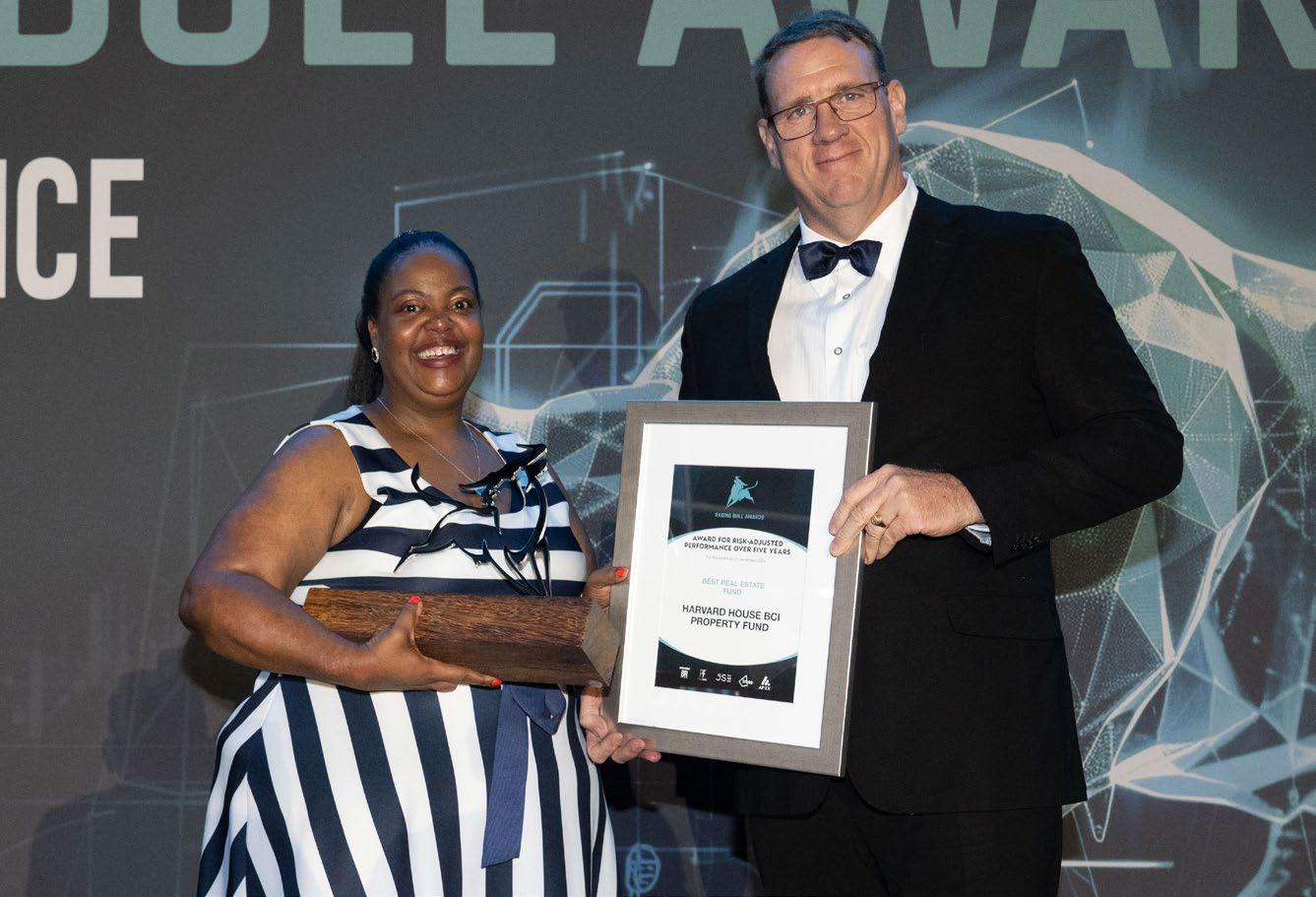

HARVARD House is a financial services group based in Howick, KwaZulu-Natal. The asset management arm of the group manages four collective investment schemes under the Boutique Collective Investment license.
The Harvard House BCI Property Fund delivered an annualised return of 8% over the last five years, almost three percentage points above its benchmark, the South African Listed Property Total Return Index, which delivered 5.1% annualised. Average CPI inflation over the period was 4.9%.
Personal Finance asked fund manager Michael Porter
about his approach to managing the fund’s property portfolio.
PF: Please describe your philosophy and process regarding investing in listed property.
MP: Our investment philosophy is anchored around the importance of generating an income from your investments, and for that income to grow from year to year. The investment universe spans all the property-related sectors of the JSE. Furthermore, it includes the flexibility to invest in selected high-yielding ordinary equities and

collective investment schemes, which means that the fund can invest in ETFs should additional diversification be required.
As a long-only asset manager, we do not undertake short selling or hedging within the portfolio. We are not benchmark huggers; we are nimble and not afraid to vary widely from the benchmark to back our convictions.
We consider property to be a long-term building block in a balanced or income-focused portfolio. This is due to property’s unique ability to escalate both income and capital over the longer term despite medium to shorter-term bouts of volatility driven by sentiment or interest-rate moves. Our investment philosophy looks to protect this increasing stream with every lever available to us, whether it be shifting geography (foreign versus local), portfolio (office vs retail vs warehousing and logistics) or business model (large regional malls, township malls or unique rental stream), as examples.
PF: Can you give a brief overview of how the local listed property market fared over the last five years, especially since the Covid pandemic.
MP: Unsurprisingly, the property sector was one of the hardest hit sectors during the pandemic. No sector was spared as malls and offices were empty, and logistics was hampered by a lack of online shopping, especially in South Africa. The pandemic was a true definition of a Black Swan event.
In addition to the fallout from the pandemic, local property companies also had to contend with the riots and extensive loadshedding. Just as some of these factors were subsiding, interest rates were raised aggressively, rubbing further salt into the wounds.
As much as this was a desperate time for the property sector, we commend management teams in general for their proactive stance. They seized the initiative, restructuring their portfolios, engaging with tenants and bankers, and getting back to the basics of day-to-day
property management. Solar was installed aggressively to contain costs, portfolios were slimmed down, debt was repaid, and rentals were rebased. That has laid the foundation for a period of stronger growth, which we have enjoyed over the past 18 months. Listed property was the best performing local asset class in both 2023 and 2024 – partly due to the low base created in Q3 2023, but also as the benefits of proactive management started to materialise.
We used the opportunity to stress test the investment case for property companies under our coverage, examining closely the structure of the balance sheet, the complexity of the business and the quality of the underlying properties. We increased exposure to higher quality companies that were better able to withstand the pressures as well as take advantage of the conditions to pursue “once-in-a-lifetime” opportunities. That has generally paid off, although we will admit to missing a few opportunities too.
PF: Looking forward, do you believe listed property can sustain its momentum of the past couple of years?
MP: Post the rallies of the past few years, we do believe that the initial rerating of the sector is now over. That said, we do expect further gains, driven by lower interest rates and an acceleration in GDP growth; provided the GNU can deliver on its mandate. The absence of loadshedding is also having a positive impact on costs, although this is being challenged by water issues, especially in Gauteng. We believe there is growing evidence of a turn in the office sector – which has been a major drag on local real estate investment trusts since the pandemic.
Not all sectors and regions will deliver similar returns. Commuter and township retail is likely to continue outperforming large urban malls, and Gauteng will remain weak, especially if political leadership remains so fractured. However, with improving sentiment, we also expect a little more corporate activity in the sector, which will keep interest alive.

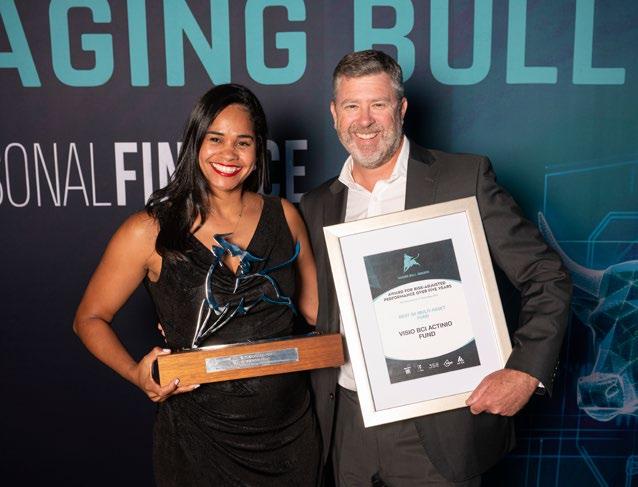
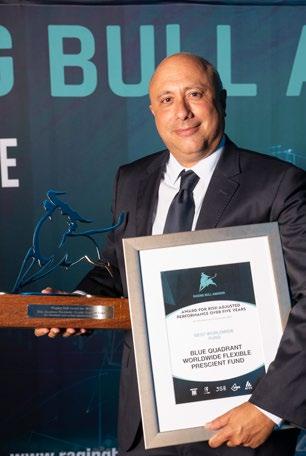
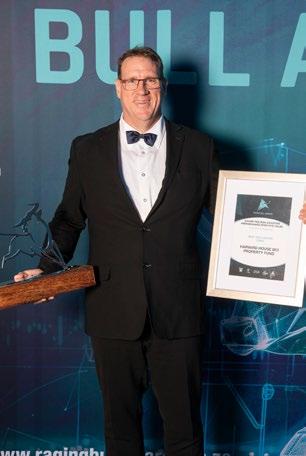
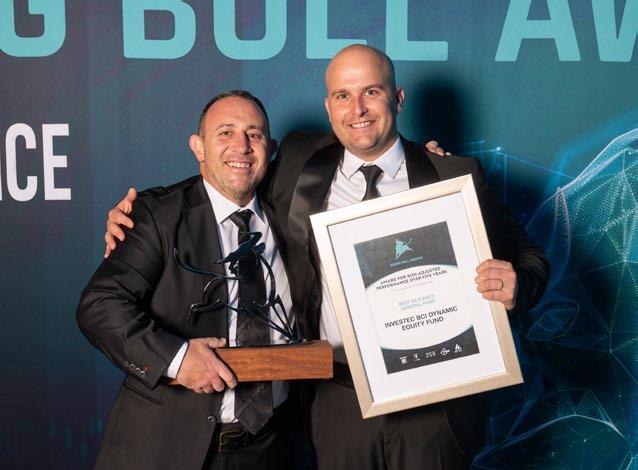
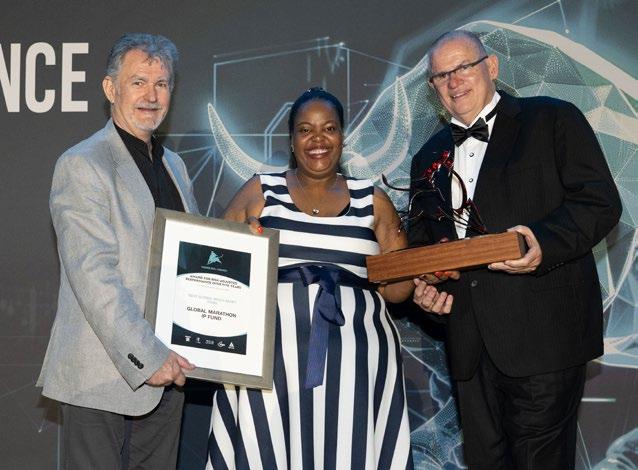

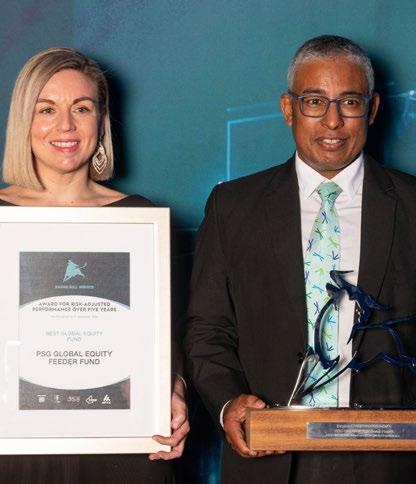
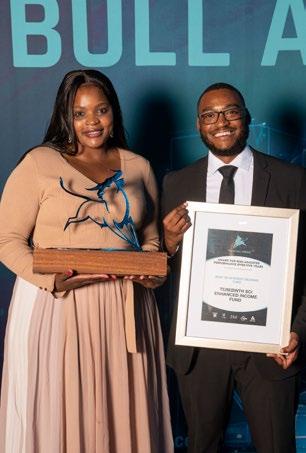

Winners cerTificaTe for sTraighT performance over 3 years
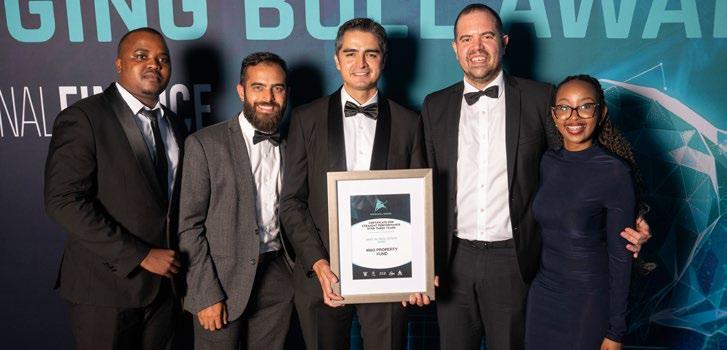
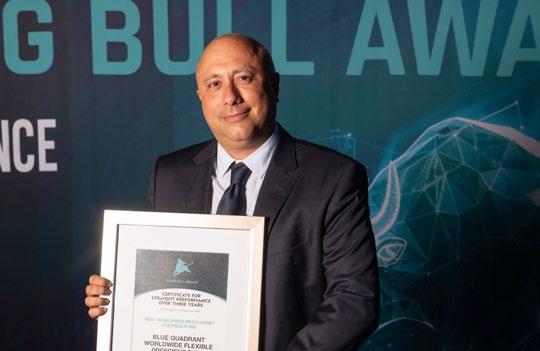
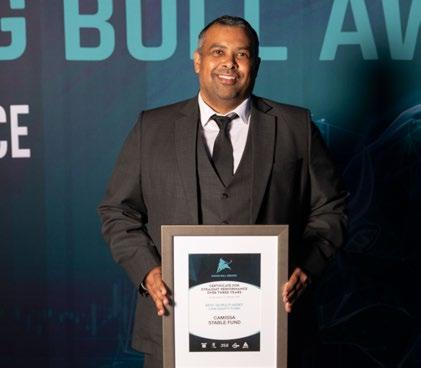
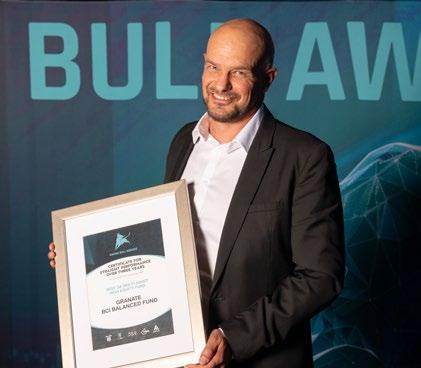
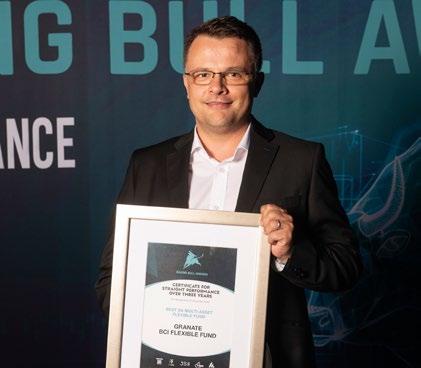
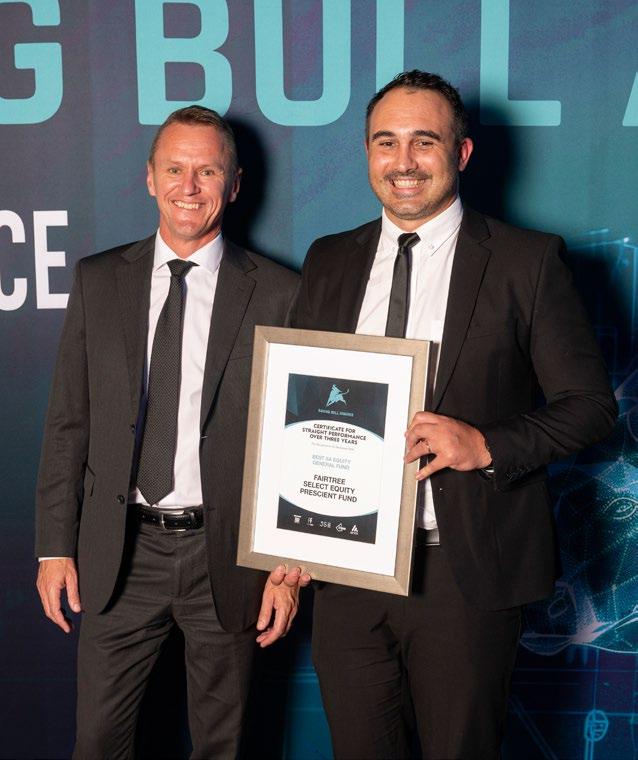
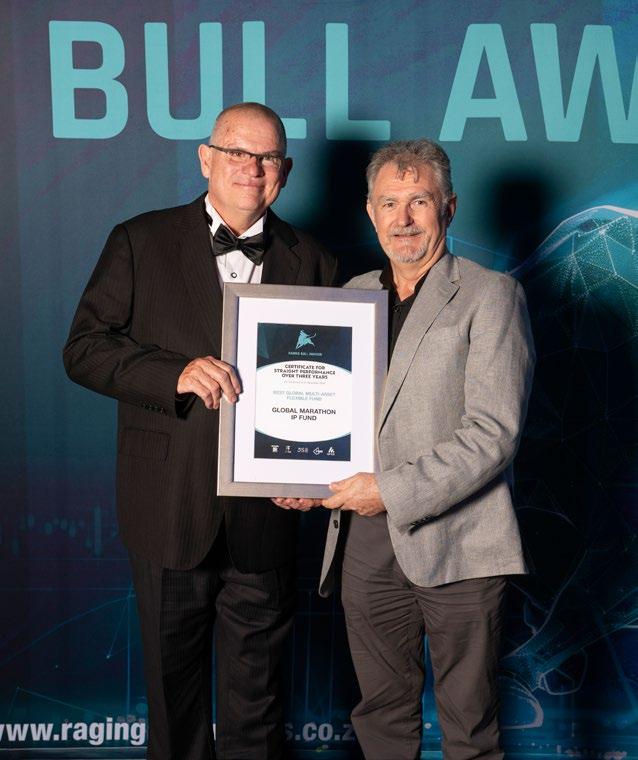

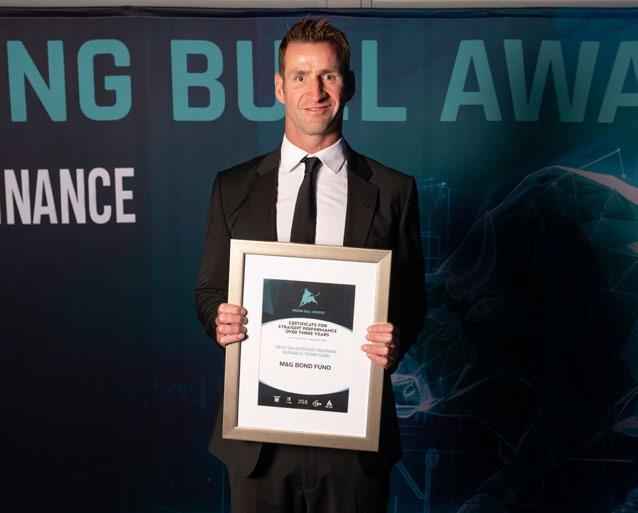


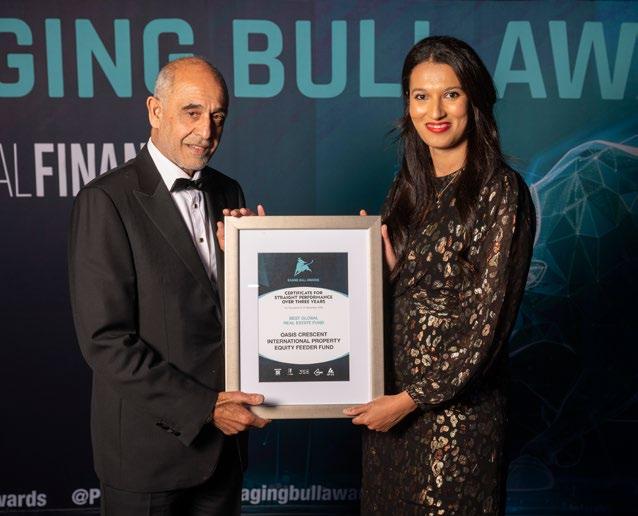
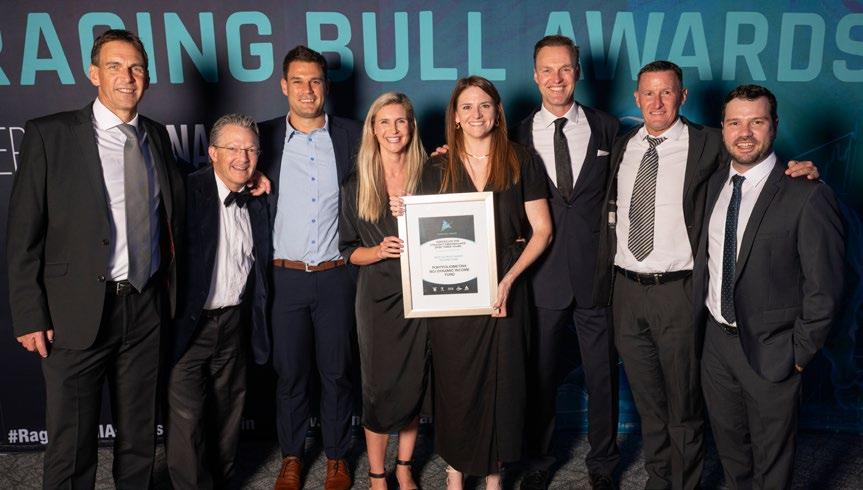
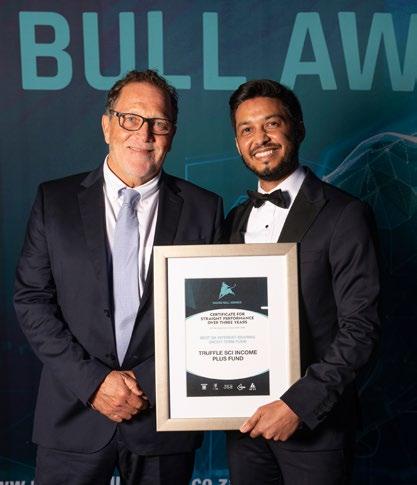




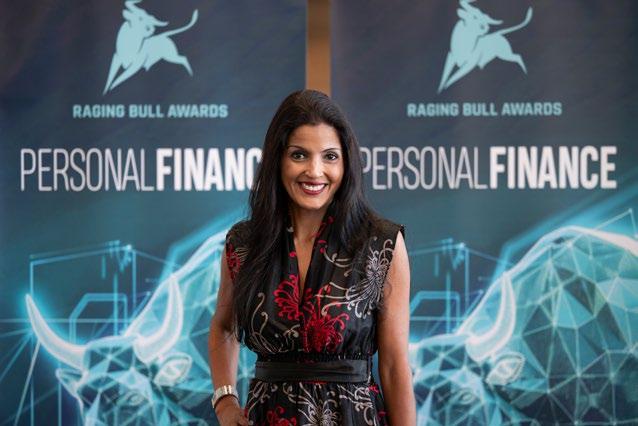










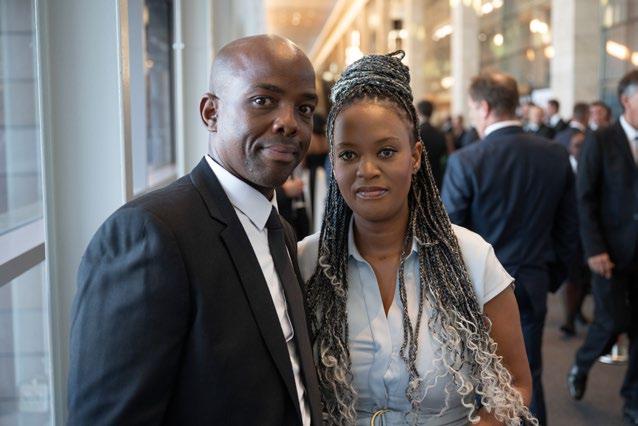
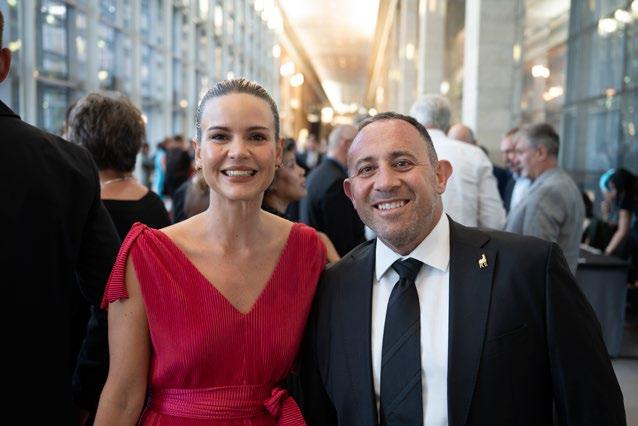
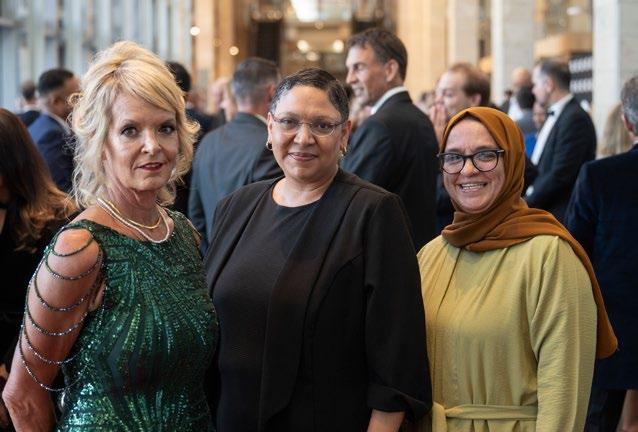




As the Calculating Agent for the 2025 Raging Bull Awards, our RiskMonitor® platform played the crucial role of producing the performance data needed to evaluate the South African investment industry’s finest.
Congratulations to all this year’s outstanding winners!

Get in touch to learn how our leading risk and regulatory risk reporting for fund management companies and fund servicers can help you transform your business. Contact Andre Le Roux, Regional Head of Sales andre.leroux@apexgroup.com clarusrisk.com
• Raging Bull Award: Best sA Interest-Bearing Fund for Risk-Adjusted performance over Five Years to December 31, 2024


TEREBINTH Capital is a black-majority-owned boutique asset manager founded in 2013 and based in Tygervalley, Western Cape. The firm manages seven unit trust funds and a hedge fund.
The Terebinth SCI Enhanced Income Fund is managed by Nomathibana Okello, Dumisani Ngwenza and Oyena Mtuzula. Personal Finance found out more about their investment approach.
PF: Please explain your process in selecting short-term instruments to achieve a solid, above-inflation return for investors needing an income.
TC: At Terebinth Capital, our investment process, applied by the fixed-income team, is centred on macroeconomic and quantitative analysis. We invest time and effort in understanding the macroeconomic environment to determine which permissible asset classes for this mandate will perform best. This is combined with our use of quantitative models to understand what is currently priced in the market.
Our approach is to construct a portfolio with a diverse source of returns, not heavily reliant on credit, a cyclical asset class. With liquidity management a key

component of our risk management strategy, we avoid equity-like credit instruments.
The return target is Short-term Fixed Interest Index (STeFI) plus one percent after fees, which ensures we are constantly aiming to maximise returns even over periods when inflation is structurally low. Thanks to our active approach to asset allocation, we have produced a return that exceeds STeFI by 1.9% and CPI by 3.6% since inception.
Our interpretation of the intention of the Interest-bearing Short-Term category is about active investment across the permissible asset classes, with a key focus on downside protection while producing inflation-beating returns over the short term.
PF: Can you describe the fund’s journey over the past five years?
TC: The economic environment over the past five years included a period of subdued inflation and, hence, interest rates, as the Reserve Bank aimed to support the economy during the Covid period when the growth outlook collapsed both globally and locally. Combined with the subsequent period of high inflation, which was later followed by high base rates, central banks aimed to curb inflation expectations so that we do not see inflation settling structurally higher. During the period with low base rates, the return on floating-rate credit was subdued, and we utilised opportunities across the government nominal and inflation-linked bonds curves as the markets priced high fiscal risk premiums compared to what would likely materialise. When base rates were increased, we increased positioning in floating-rate instruments and inflation-linked bonds that benefited from a total-return perspective in a high interest rate and inflation environment.
This is what differentiates us. We actively navigate exposure across nominal and inflation-linked bonds and
across their curves, and short-dated bank instruments (fixed and floating). Hence, we did not rely solely on credit.
PF: Looking forward over the next year or two, what do you expect from interest rates and inflation, considering a relatively buoyant local economy currently?
TC: Understanding how the local economy might decouple from global factors is crucial in the next year or two to ascertain the impact on local interest rates and inflation. The inward-looking nature of the Trump administration’s imposing tariffs on trading partners may have growth implications for trading peers while temporarily boosting US growth. The US Federal Reserve is in a watch-and-see mode as it tries to ascertain the impact of fiscal policies on the labour market and inflation.
Locally, the growth outlook has improved as the Government of National Unity has been key in enhancing the external investor base view on South Africa. We are seeing policy actions via energy and the network systems improve operations. There are targeted efforts to remove South Africa from the Financial Action Task Force greylisting by focusing on crime and corruption reduction.
Therefore, we will likely see inflation settling comfortably within the Reserve Bank’s lower target band, opening the scope for it to continue normalising base rates lower. However, we are mindful that the SARB will watch the impact of our base rate differential to US rates, given the impact on the local currency and, hence, the potential filter through to inflation in an environment where the US Fed is not in a hurry to cut rates further. From a fund positioning perspective, the risk premium in short-term interest rates is subdued, and we need to be agile across the curve to maximise returns.
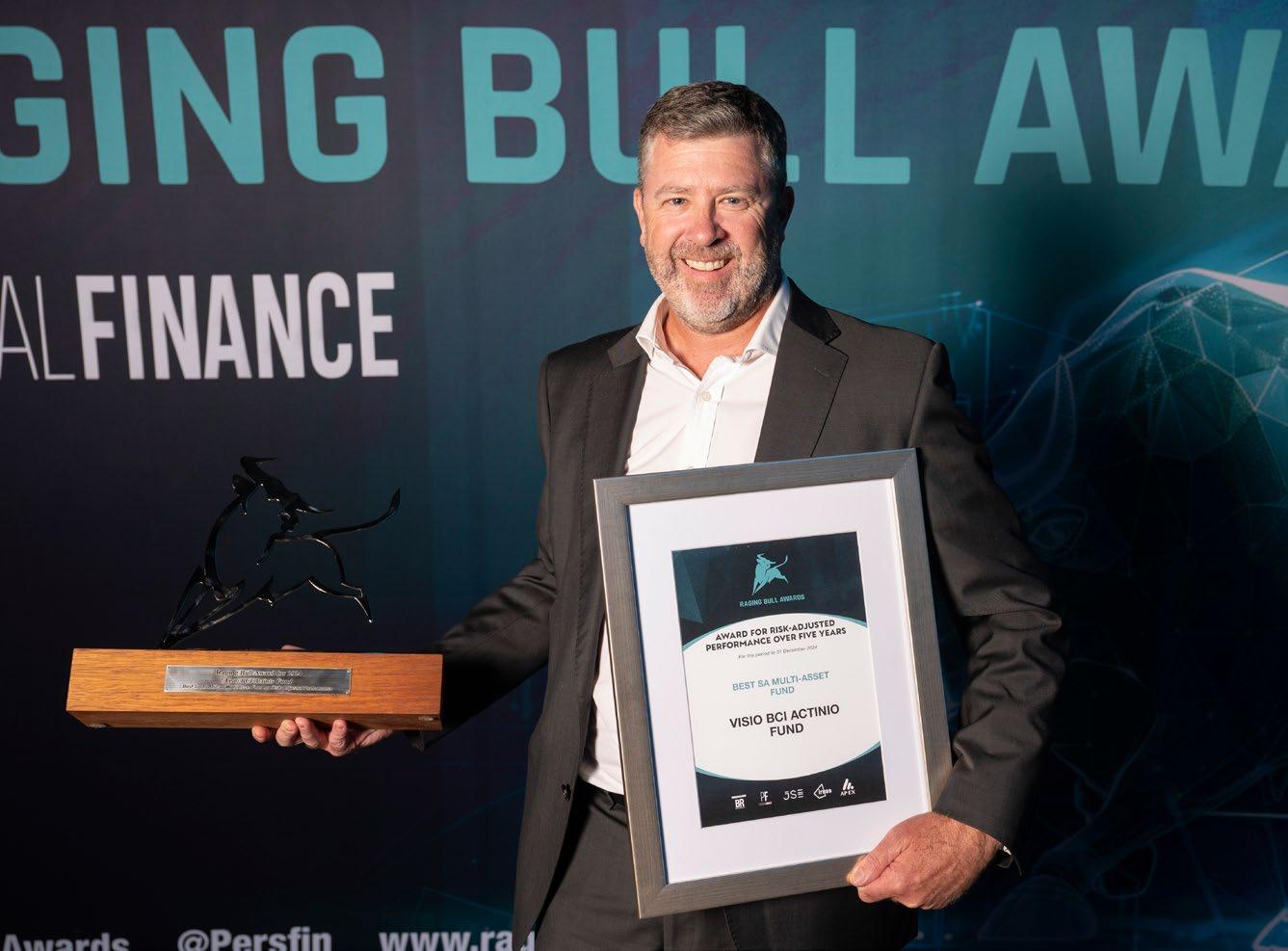
VISIO Fund Management is a boutique asset manager based in Sandton that operates a range of unit trust funds and hedge funds under the Boutique Collective Investments licence.
Its Actinio Fund is in the SA Multi-asset Flexible sub-category, giving its portfolio managers a wide mandate to invest across asset classes and up to 45% offshore.
Personal Finance asked fund manager and Visio founder Patrice Moyal about his approach to managing the portfolio.
PF: Please explain your philosophy regarding asset

allocation, offshore exposure and security selection at asset-class level.
PM: Our philosophy is focused on investment opportunities identified by Visio’s team. The fund arose from the work we do in the Visio hedge funds, and to this day, 21 years since launch of the fund, the top holdings in Actinio mimic those of our top hedge fund long ideas. This includes shares, bonds, listed property and cash, both locally and offshore. The portfolio’s ultimate composition is based on building portfolios focused on best ideas and balancing risk with reward or perceived upside. A highly concentrated portfolio of less than

30 positions, with an emphasis on thorough bottom-up fundamental research, we aim to:
¡ Find investments that can be bought for less than we believe they are worth or trading below intrinsic value.
¡ Look for opportunities to unlock value through engaging with companies.
¡ Factor in a generous margin of downside, which remains the key determinant for inclusion in the portfolio.
We pride ourselves on doing thorough research in both the usual and not-so-obvious places to find the best opportunities for our investors. Over many years, Visio has developed a consistent and dedicated approach to managing risk, with a focus on protecting investors from big losses.
PF: To what do you attribute your annualised performance of 12% over five years, nearly four percentage points above your benchmark of CPI+3%, with less volatility than many multi-asset fund peers?
PM: Two stand-out years over the last five years were 2021 and 2024. In 2021 the Actinio Fund was able to capture the post Covid “bounce” and stay ahead of the market (FTSE/JSE All Share Index).
Key contributors in 2021 were locally listed counters in telecoms (MTN), industrials (Motus, RMB Holdings, Distell), property (Arrowhead), education (AdvTech) and packaging (Sappi and Nampak). The top performers in 2024 included global exposures (in the main Prosus, TSMC, Meta, Amazon, Berkshire Hathaway and Hipgnosis), insurance (Just Group offshore and Momentum), property (Fairvest, NEPI & Hyprop), retail (Shoprite, Boxer and Tiger Brands), financials (Alexforbes) and banking (Absa).
PF: The future looks choppy for financial markets.
How will you manage the expected volatility?
PM: We expect volatility to be elevated in 2025 driven by the tariff risks, potentially higher inflation and the possibility of corresponding higher interest rates. However, we believe South African equities could deliver 15% to 20% returns due to attractive valuations and higher earnings growth. In our view, the risk reward for South African equities is attractive as a number of positive factors will drive higher earnings growth in 2025, including:
¡ Continuing improvement in employment, with 223 000 jobs created in the first nine months; • Consumer demand, which has accelerated post September 2024 evidenced by retail company updates; and
¡ Banks pointing to lower bad debts and an acceleration in loans.
From a domestic perspective we continue to prefer SA Inc companies as we believe there is upside risk to our earnings forecasts and valuations driven by reforms, higher consumer disposable incomes and potential capital investment by both government and business. Here we favour select industrials, discretionary retail, banks and underappreciated non-discretionary consumer goods and services as we expect these sectors to show market-leading earnings growth while valuations remain compelling. We expect earnings to conservatively grow to low and mid-teens over the next two years, which is attractive in a global environment expected to be dominated by uncertainty.
Looking abroad, valuations in the US, particularly in big tech, are fairly demanding and global tensions remain high. We are exercising caution going into 2025 and maintaining our focus primarily on companies generating strong cashflows with acceptable valuations. From time to time we do add protection to the portfolio with the use of index hedges.



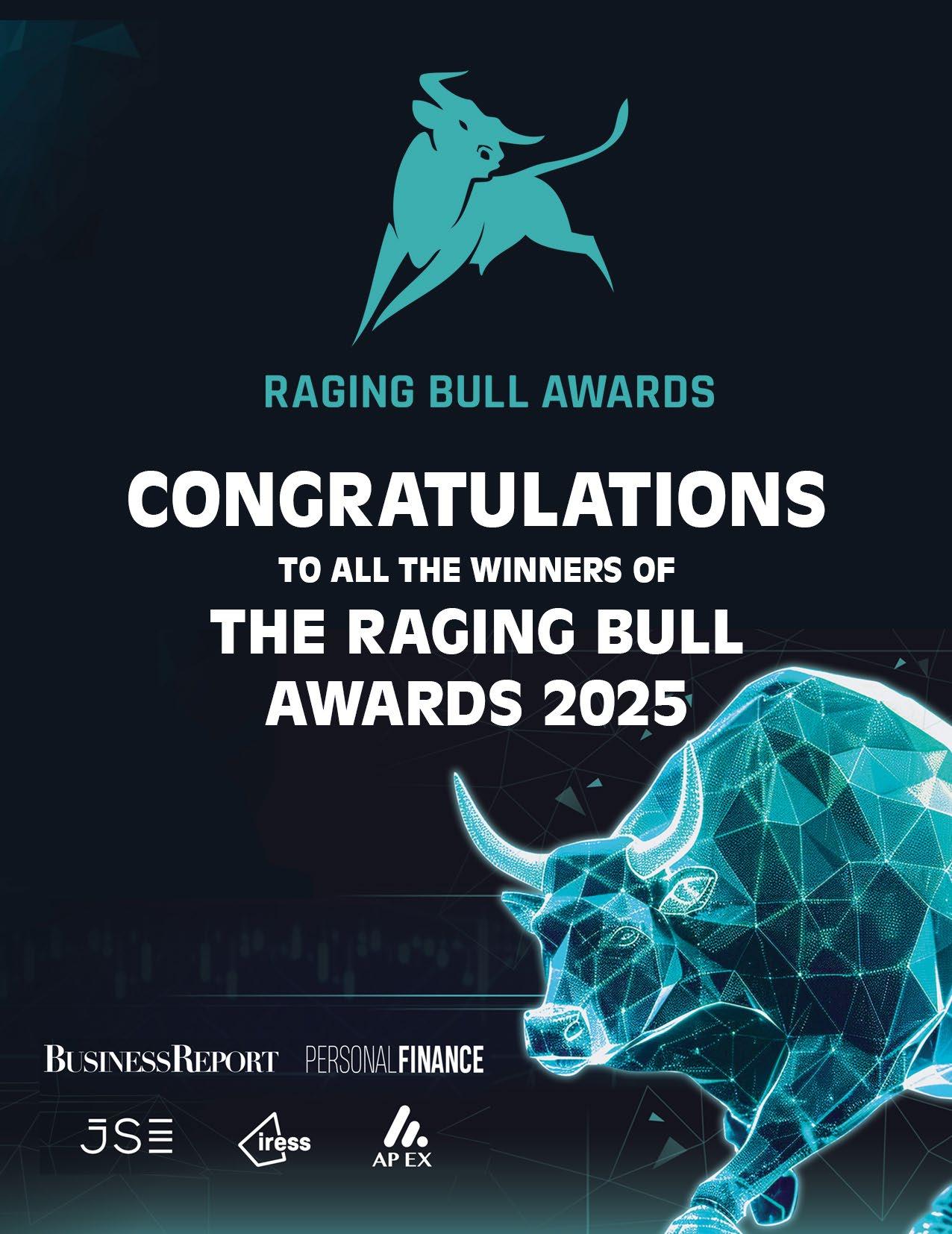
TO ALL THE WINNERS OF THE RAGING BULL AWARDS
